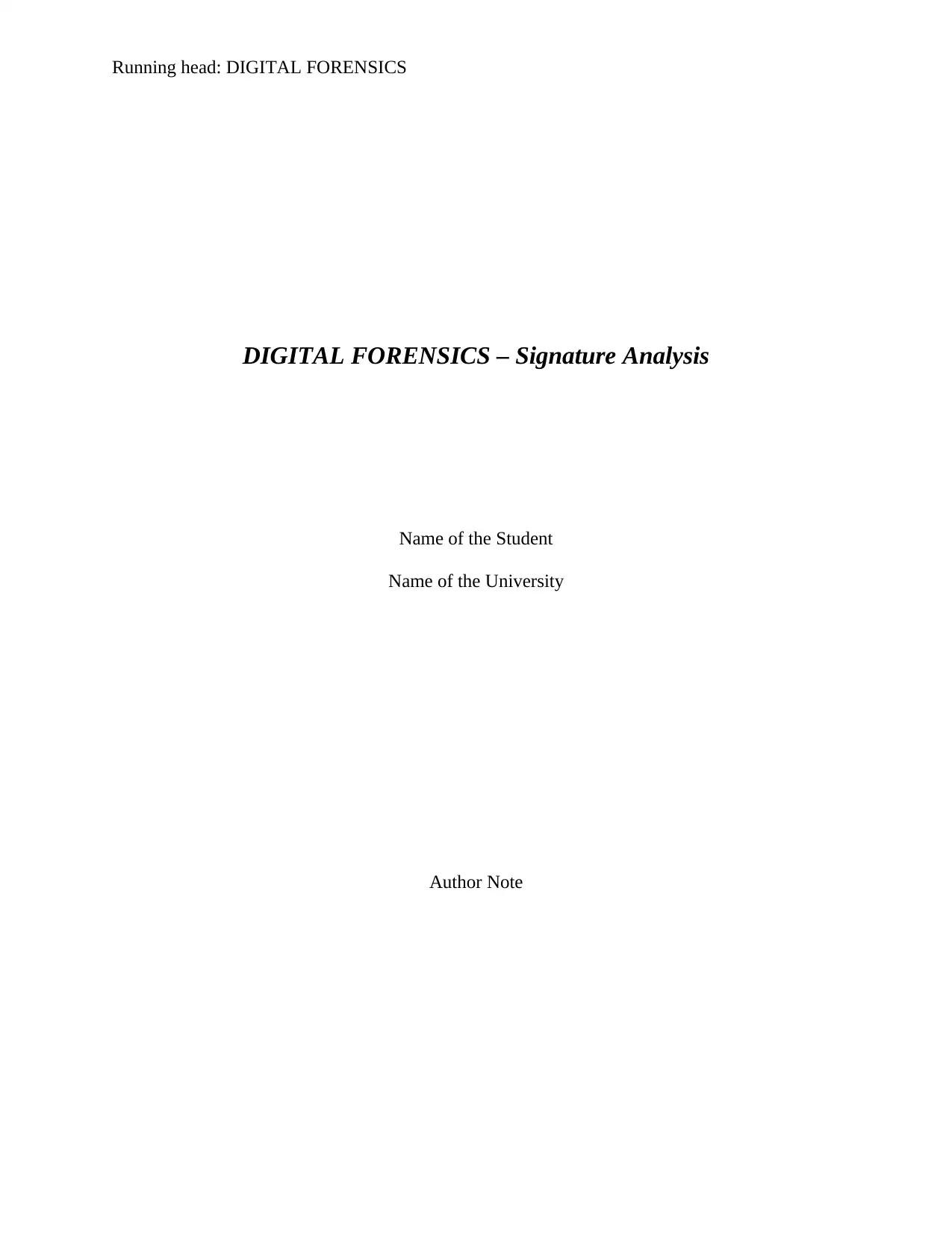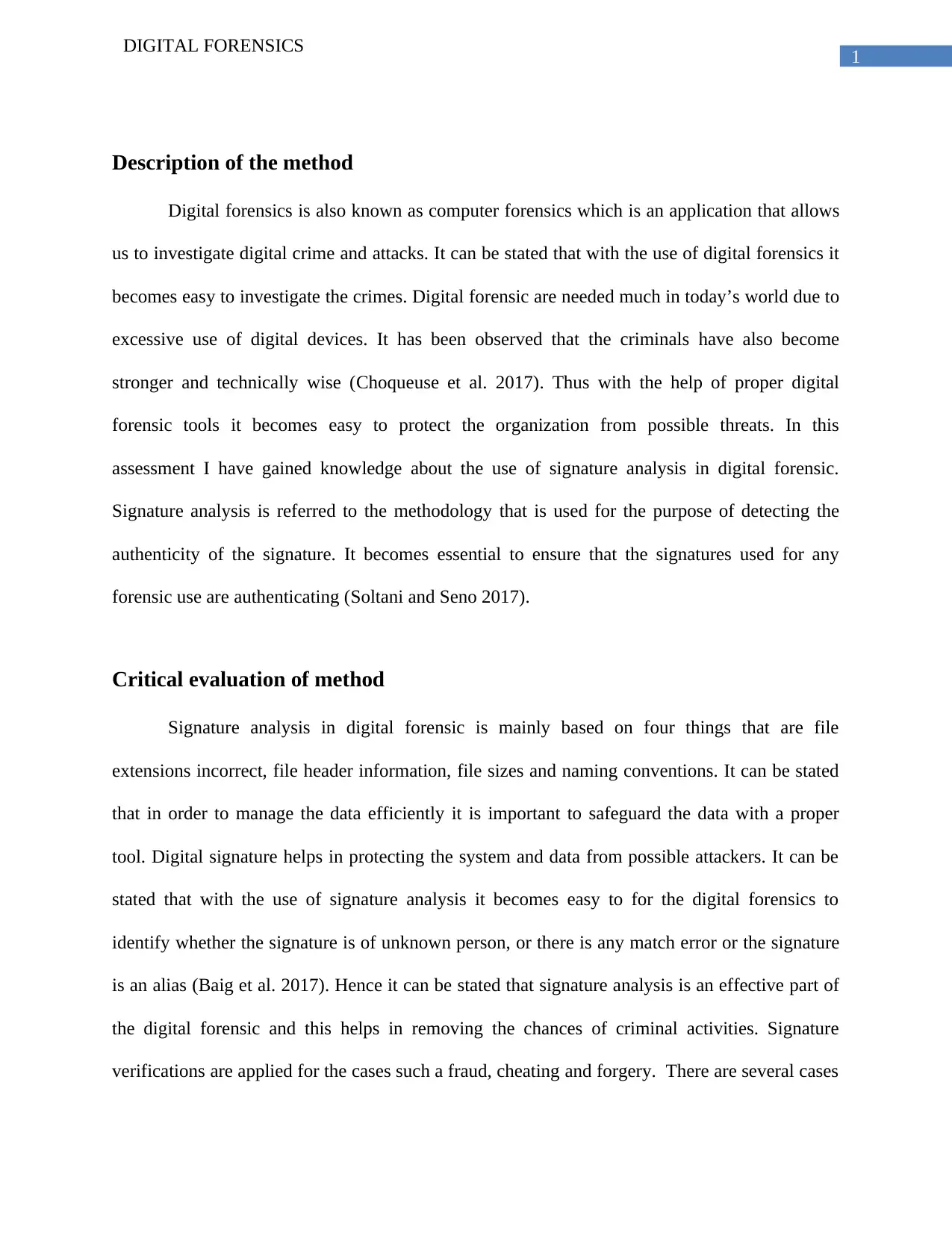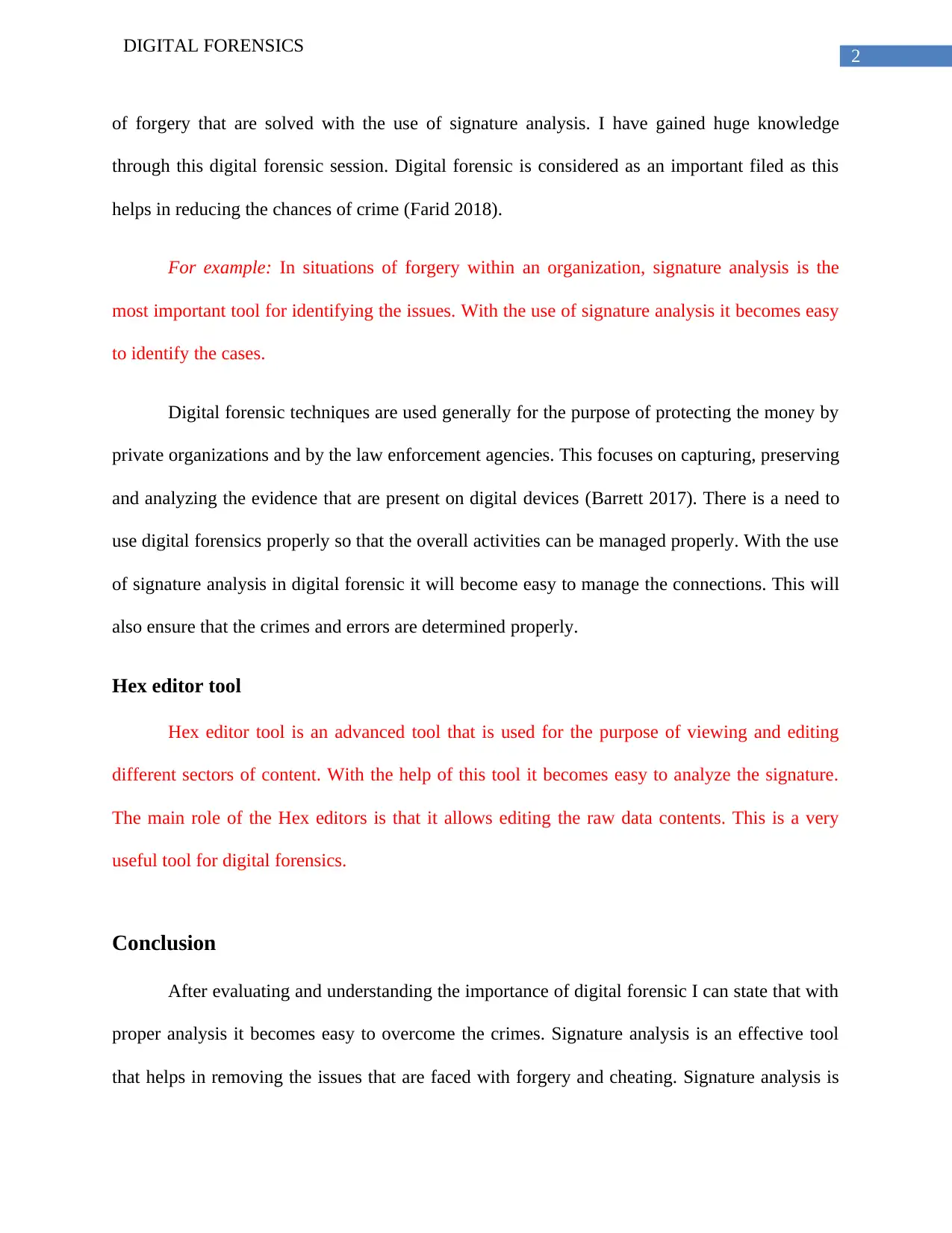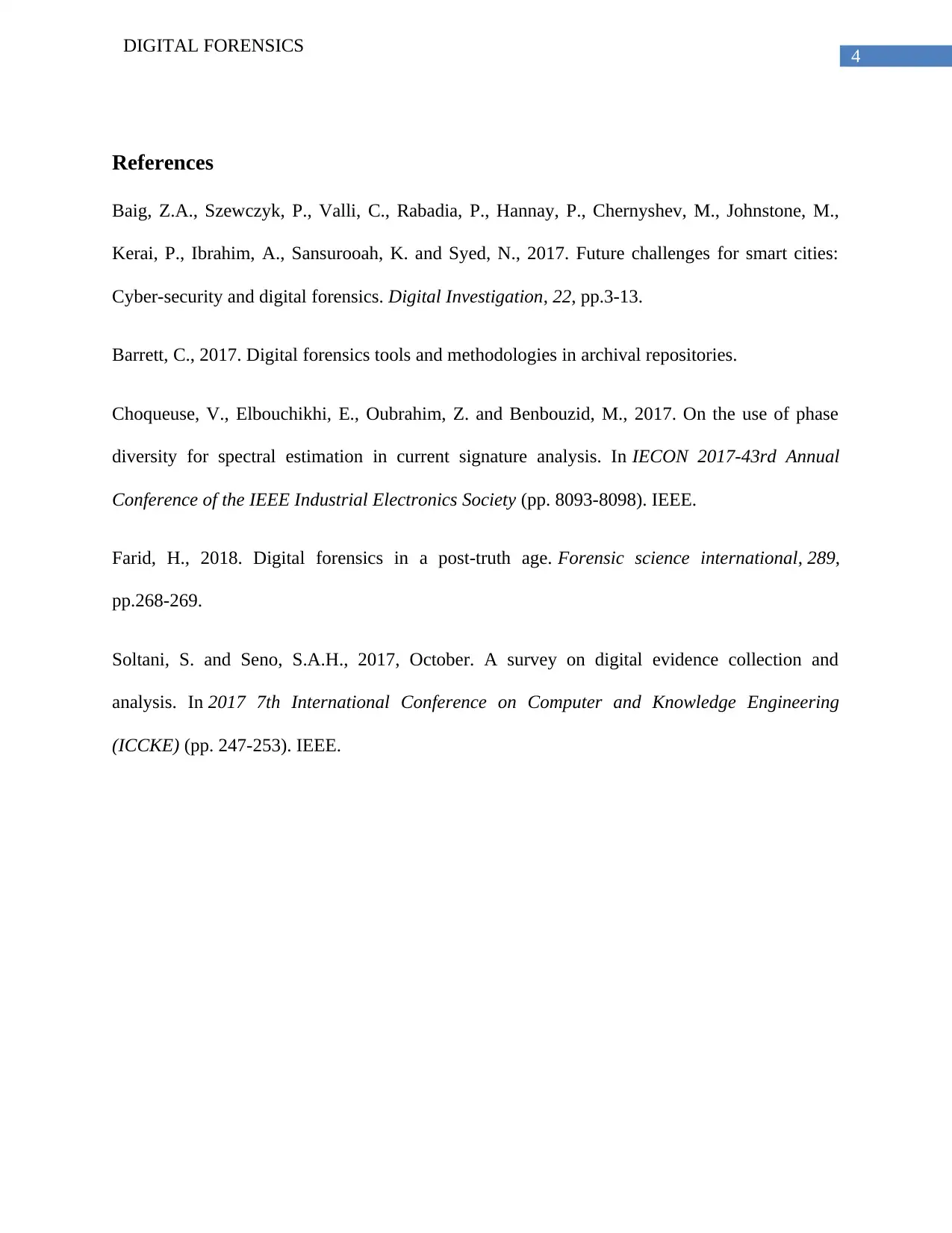Digital Forensics: A Reflective Essay on Signature Analysis Skills
VerifiedAdded on 2022/08/25
|5
|895
|16
Essay
AI Summary
This essay provides a personal reflection on the learning experience of signature analysis within the context of a digital forensics module. It delves into the importance of signature analysis for verifying the authenticity of digital signatures and its role in identifying forgery, fraud, and other digital crimes. The reflection covers the critical evaluation of the method, focusing on file extensions, header information, file sizes, and naming conventions. The essay also highlights the use of Hex editor tool for analyzing signatures and emphasizes the overall significance of digital forensics in protecting data and managing cyber threats. It concludes by asserting that signature analysis is a vital tool in identifying criminals and mitigating issues related to data security, emphasizing that Desklib provides resources for students.

Running head: DIGITAL FORENSICS
DIGITAL FORENSICS – Signature Analysis
Name of the Student
Name of the University
Author Note
DIGITAL FORENSICS – Signature Analysis
Name of the Student
Name of the University
Author Note
Paraphrase This Document
Need a fresh take? Get an instant paraphrase of this document with our AI Paraphraser

1
DIGITAL FORENSICS
Description of the method
Digital forensics is also known as computer forensics which is an application that allows
us to investigate digital crime and attacks. It can be stated that with the use of digital forensics it
becomes easy to investigate the crimes. Digital forensic are needed much in today’s world due to
excessive use of digital devices. It has been observed that the criminals have also become
stronger and technically wise (Choqueuse et al. 2017). Thus with the help of proper digital
forensic tools it becomes easy to protect the organization from possible threats. In this
assessment I have gained knowledge about the use of signature analysis in digital forensic.
Signature analysis is referred to the methodology that is used for the purpose of detecting the
authenticity of the signature. It becomes essential to ensure that the signatures used for any
forensic use are authenticating (Soltani and Seno 2017).
Critical evaluation of method
Signature analysis in digital forensic is mainly based on four things that are file
extensions incorrect, file header information, file sizes and naming conventions. It can be stated
that in order to manage the data efficiently it is important to safeguard the data with a proper
tool. Digital signature helps in protecting the system and data from possible attackers. It can be
stated that with the use of signature analysis it becomes easy to for the digital forensics to
identify whether the signature is of unknown person, or there is any match error or the signature
is an alias (Baig et al. 2017). Hence it can be stated that signature analysis is an effective part of
the digital forensic and this helps in removing the chances of criminal activities. Signature
verifications are applied for the cases such a fraud, cheating and forgery. There are several cases
DIGITAL FORENSICS
Description of the method
Digital forensics is also known as computer forensics which is an application that allows
us to investigate digital crime and attacks. It can be stated that with the use of digital forensics it
becomes easy to investigate the crimes. Digital forensic are needed much in today’s world due to
excessive use of digital devices. It has been observed that the criminals have also become
stronger and technically wise (Choqueuse et al. 2017). Thus with the help of proper digital
forensic tools it becomes easy to protect the organization from possible threats. In this
assessment I have gained knowledge about the use of signature analysis in digital forensic.
Signature analysis is referred to the methodology that is used for the purpose of detecting the
authenticity of the signature. It becomes essential to ensure that the signatures used for any
forensic use are authenticating (Soltani and Seno 2017).
Critical evaluation of method
Signature analysis in digital forensic is mainly based on four things that are file
extensions incorrect, file header information, file sizes and naming conventions. It can be stated
that in order to manage the data efficiently it is important to safeguard the data with a proper
tool. Digital signature helps in protecting the system and data from possible attackers. It can be
stated that with the use of signature analysis it becomes easy to for the digital forensics to
identify whether the signature is of unknown person, or there is any match error or the signature
is an alias (Baig et al. 2017). Hence it can be stated that signature analysis is an effective part of
the digital forensic and this helps in removing the chances of criminal activities. Signature
verifications are applied for the cases such a fraud, cheating and forgery. There are several cases

2
DIGITAL FORENSICS
of forgery that are solved with the use of signature analysis. I have gained huge knowledge
through this digital forensic session. Digital forensic is considered as an important filed as this
helps in reducing the chances of crime (Farid 2018).
For example: In situations of forgery within an organization, signature analysis is the
most important tool for identifying the issues. With the use of signature analysis it becomes easy
to identify the cases.
Digital forensic techniques are used generally for the purpose of protecting the money by
private organizations and by the law enforcement agencies. This focuses on capturing, preserving
and analyzing the evidence that are present on digital devices (Barrett 2017). There is a need to
use digital forensics properly so that the overall activities can be managed properly. With the use
of signature analysis in digital forensic it will become easy to manage the connections. This will
also ensure that the crimes and errors are determined properly.
Hex editor tool
Hex editor tool is an advanced tool that is used for the purpose of viewing and editing
different sectors of content. With the help of this tool it becomes easy to analyze the signature.
The main role of the Hex editors is that it allows editing the raw data contents. This is a very
useful tool for digital forensics.
Conclusion
After evaluating and understanding the importance of digital forensic I can state that with
proper analysis it becomes easy to overcome the crimes. Signature analysis is an effective tool
that helps in removing the issues that are faced with forgery and cheating. Signature analysis is
DIGITAL FORENSICS
of forgery that are solved with the use of signature analysis. I have gained huge knowledge
through this digital forensic session. Digital forensic is considered as an important filed as this
helps in reducing the chances of crime (Farid 2018).
For example: In situations of forgery within an organization, signature analysis is the
most important tool for identifying the issues. With the use of signature analysis it becomes easy
to identify the cases.
Digital forensic techniques are used generally for the purpose of protecting the money by
private organizations and by the law enforcement agencies. This focuses on capturing, preserving
and analyzing the evidence that are present on digital devices (Barrett 2017). There is a need to
use digital forensics properly so that the overall activities can be managed properly. With the use
of signature analysis in digital forensic it will become easy to manage the connections. This will
also ensure that the crimes and errors are determined properly.
Hex editor tool
Hex editor tool is an advanced tool that is used for the purpose of viewing and editing
different sectors of content. With the help of this tool it becomes easy to analyze the signature.
The main role of the Hex editors is that it allows editing the raw data contents. This is a very
useful tool for digital forensics.
Conclusion
After evaluating and understanding the importance of digital forensic I can state that with
proper analysis it becomes easy to overcome the crimes. Signature analysis is an effective tool
that helps in removing the issues that are faced with forgery and cheating. Signature analysis is
⊘ This is a preview!⊘
Do you want full access?
Subscribe today to unlock all pages.

Trusted by 1+ million students worldwide

3
DIGITAL FORENSICS
the most efficient tool that helps in identification of the criminals. Thus it can be stated that with
the help of proper tools and technologies it becomes easy to mitigate the issues. Hence I can
conclude that with the use of signature analysis in digital forensic it becomes easy to manage the
data security.
DIGITAL FORENSICS
the most efficient tool that helps in identification of the criminals. Thus it can be stated that with
the help of proper tools and technologies it becomes easy to mitigate the issues. Hence I can
conclude that with the use of signature analysis in digital forensic it becomes easy to manage the
data security.
Paraphrase This Document
Need a fresh take? Get an instant paraphrase of this document with our AI Paraphraser

4
DIGITAL FORENSICS
References
Baig, Z.A., Szewczyk, P., Valli, C., Rabadia, P., Hannay, P., Chernyshev, M., Johnstone, M.,
Kerai, P., Ibrahim, A., Sansurooah, K. and Syed, N., 2017. Future challenges for smart cities:
Cyber-security and digital forensics. Digital Investigation, 22, pp.3-13.
Barrett, C., 2017. Digital forensics tools and methodologies in archival repositories.
Choqueuse, V., Elbouchikhi, E., Oubrahim, Z. and Benbouzid, M., 2017. On the use of phase
diversity for spectral estimation in current signature analysis. In IECON 2017-43rd Annual
Conference of the IEEE Industrial Electronics Society (pp. 8093-8098). IEEE.
Farid, H., 2018. Digital forensics in a post-truth age. Forensic science international, 289,
pp.268-269.
Soltani, S. and Seno, S.A.H., 2017, October. A survey on digital evidence collection and
analysis. In 2017 7th International Conference on Computer and Knowledge Engineering
(ICCKE) (pp. 247-253). IEEE.
DIGITAL FORENSICS
References
Baig, Z.A., Szewczyk, P., Valli, C., Rabadia, P., Hannay, P., Chernyshev, M., Johnstone, M.,
Kerai, P., Ibrahim, A., Sansurooah, K. and Syed, N., 2017. Future challenges for smart cities:
Cyber-security and digital forensics. Digital Investigation, 22, pp.3-13.
Barrett, C., 2017. Digital forensics tools and methodologies in archival repositories.
Choqueuse, V., Elbouchikhi, E., Oubrahim, Z. and Benbouzid, M., 2017. On the use of phase
diversity for spectral estimation in current signature analysis. In IECON 2017-43rd Annual
Conference of the IEEE Industrial Electronics Society (pp. 8093-8098). IEEE.
Farid, H., 2018. Digital forensics in a post-truth age. Forensic science international, 289,
pp.268-269.
Soltani, S. and Seno, S.A.H., 2017, October. A survey on digital evidence collection and
analysis. In 2017 7th International Conference on Computer and Knowledge Engineering
(ICCKE) (pp. 247-253). IEEE.
1 out of 5
Related Documents
Your All-in-One AI-Powered Toolkit for Academic Success.
+13062052269
info@desklib.com
Available 24*7 on WhatsApp / Email
![[object Object]](/_next/static/media/star-bottom.7253800d.svg)
Unlock your academic potential
Copyright © 2020–2025 A2Z Services. All Rights Reserved. Developed and managed by ZUCOL.





